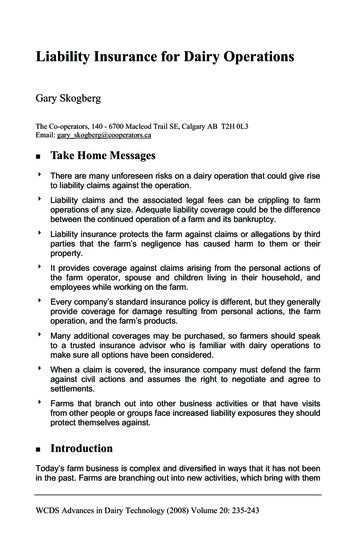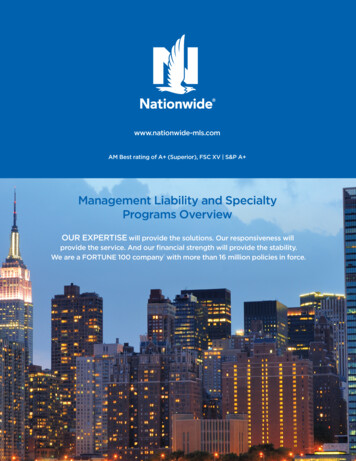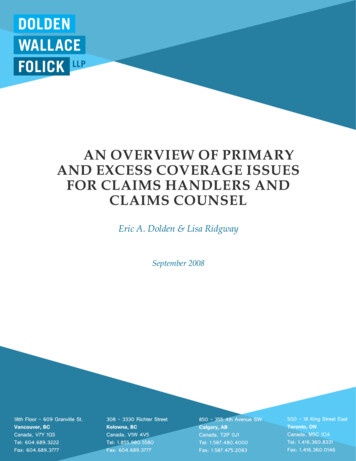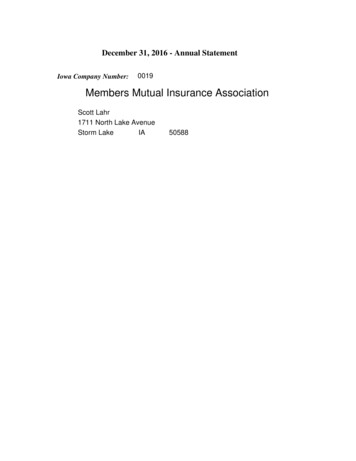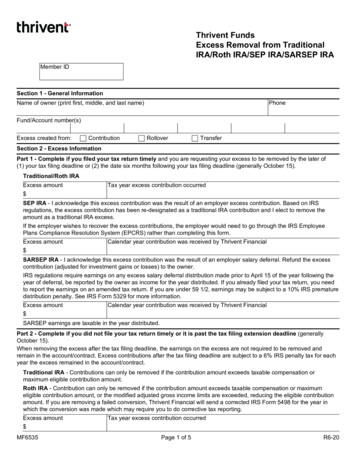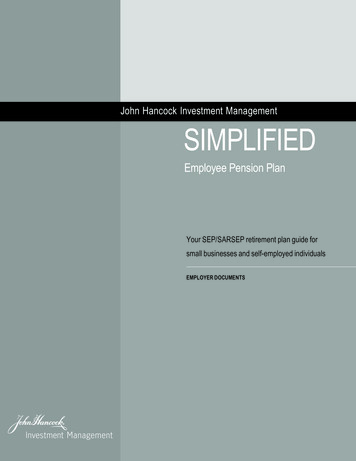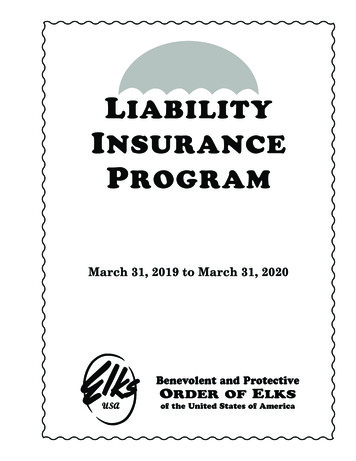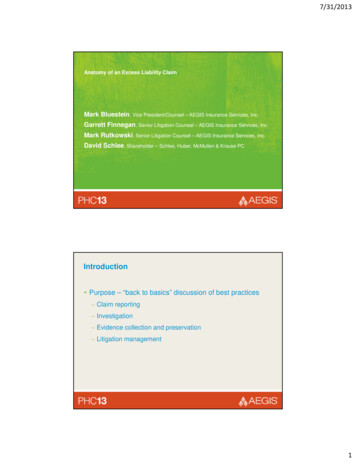
Transcription
7/31/2013Anatomy of an Excess Liability ClaimMark Bluestein, Vice President/Counsel – AEGIS Insurance Services, Inc.Garrett Finnegan, Senior Litigation Counsel – AEGIS Insurance Services, Inc.Mark Rutkowski, Senior Litigation Counsel – AEGIS Insurance Services, Inc.David Schlee, Shareholder – Schlee, Huber, McMullen & Krause PCIntroduction Purpose – “back to basics” discussion of best practices Claim reporting Investigation Evidence collection and preservation Litigation management1
7/31/2013Claims Procedures AEGIS provides specific guidelines to assist in effectiveclaims management “Assure Effective Management of Claims and ClaimsServices and Appropriate Advice to AEGIS and itsMembers Regarding Claims Issues to Achieve theBusiness Objectives.” Claims Procedure Guide is available throughAEGISlink.comAEGIS Claims Reporting Protocol2
7/31/2013AEGIS Claims Reporting Protocol Importance of “prompt reporting” Proper and timely reporting of claims requires a clearunderstanding of what and how to report Any uncertainties should be clarified by discussionswith the Claims DivisionAEGIS Claims Reporting Requirements per PolicyThe AEGIS Excess Liability Insurance Policy provides that“As a condition precedent to rights under this POLICY, the INSUREDshall as soon as practicable give the COMPANY:1. Written notice of any CLAIM made against any INSUREDestimated by the INSURED to involve ULTIMATE NET LOSSin excess of fifty percent (50%) of the UNDERLYING LIMITshown in Item 6 of the Declarations, or2. NOTICE OF CIRCUMSTANCES for any OCCURRENCE orCircumstances likely to give rise to a CLAIM to Condition (C) (1)would apply;and such information and cooperation as the COMPANY may reasonablyrequire. Neither Application for this POLICY or any Endorsementor for any renewals thereof nor any information contained therein shallconstitute a notice of CLAIM or NOTICE OF CIRCUMSTANCES.”3
7/31/2013AEGIS Claims Reporting RequirementsWhen to Report All occurrences or claims wherein the member’s reserveor evaluation is 50% or more of the self-insured retention Any occurrence which may give rise to a claim creating potentialexposure to AEGIS regardless of the self-insured retention Any claim or class of claim, involving latent injury or damage Where the injury or damage develops over time Where the time of the injury or damage is uncertain Where there is repeated exposure before an injury or damageis manifested All potential claims involving serious injuriesSerious Injuries Death Brain damage Injuries resulting inmultiple deaths Extensive burns Substantial propertydamage Paraplegia All class actions Amputations All other injuries likelyto result in a permanentdisability rating of 50%or more4
7/31/2013AEGIS Claims Reporting RequirementsWhere to Report A member should acquire sufficient factual informationand report promptly in writing to:AEGIS Insurance Services Inc.Claims DivisionOne Meadowlands PlazaEast Rutherford, NJ 07073Bruce W. Roznowski, Senior Vice PresidentBruceRoznowski@aegislimited.comAEGIS Claims Reporting RequirementsWhere to Report Members and brokers can also report electronically onour website:www.aegislink.com To obtain access to our website if you do not have apassword, please contact our Claims DivisionAdministrator, Cindy 8655
7/31/2013AEGISlink.com“My Claims” New claims system User-friendly reporting processIncident Investigation6
7/31/2013The Window of Opportunity Official investigators at site Providing cover Witness interviews Before they clam up Preserve physical evidence Before it goes awayThe Investigation TeamCounsel Outside counsel vs. inside counsel Privilege issues Anticipation of litigation vs. standard company practice Insurer / insured privilege Inside counsel should only handle litigation – e.g., generalcounsel may not preserve privilege Counsel as team leader7
7/31/2013Scene Documentation 3D laser scan technology May replace much of the traditional measurementand photography work Larger engineering firms have it Can also document explosion damageThe Investigation TeamExperts Company employees vs. outside consultants Disciplines Fire cause and origin Engineer Metallurgy / plastics Odorant – chemist Industry codes and standards Gas migration Sewer gas and sewer systems8
7/31/2013Command and Control Essential – decision-maker in charge Guidance for investigation Guidance for interaction with outside investigators Evidence preservation Evidence control Communications controlPermission to Enter Scene Official investigating agency Can give permission if scene not released Should advise official investigator even if scene is released Invite attendance If scene released – need owner permission Permission from property insurance carrier If representative is on scene If not, best to go to owner9
7/31/2013Check the EquipmentGas Odorometer, CGI, CO detector Selection of unit – check service history Used unit – track record Record serial number for unit Check calibration of unit Combustible Gas Indicator (CGI) Hose – not new Odorometer Hose – newCompany Personnel on Scene Limit the number of personnel Media and adverse investigators Audio and video recorders Instructions Do not talk to outsiders Be professional – no wisecracks Refer inquiries to spokesperson Exception: official investigators Stick to the facts – no opinions10
7/31/2013Handling of Physical Evidence Photograph the evidence in place The fire scene is evidence Note the location on diagram Who owns the evidence? If someone else Document the preservation request Set up spoliation claim Extreme case: legal action If your company Chain of custody documentation Storage – secure locationOdorometer Tests Do this as soon as possible Closest location to the incident location Consider several locations Use several different testers Check for colds, allergies, etc. Can be done by company personnel (2) Separate reading by official investigator on scene Two readings First odor Readily detectible11
7/31/2013Witness Interviews Window of opportunity Attorney or under attorney guidance Documentation – attorney memo, including impressionsof witness(es) Decision as to statements, affidavits, recording Company personnel on alert If they overhear information, get to counsel for follow-upEmployee Interviews Do not record audio – no need Exception – if employee is to be terminated or disciplined Attorney interview only – not by non-legal personnelunless at direction of attorney Attorney makes memo of the interview Control who is present – only those needed for technicalsupport Former employees Union issues – union representative present?12
7/31/2013Interviews by Official Personnel Cooperation is important Just the facts – no opinions, unless obvious Should have identified and interviewed keypersonnel before But can't defer or delay Attorney can be present, but don't make a big issue of it.Ask but don't insist. There are exceptions If “barred,” then perhaps insistThe Media Designate a spokesperson – and stick to it Should NOT be counsel Usually company communications director Used to dealing with the press Knows the personalities Company personnel instructed to refer inquiries tospokesperson – training13
7/31/2013EvidenceAn ExampleEvidenceAn Example14
7/31/2013Document Control and Preservation of EvidenceDocuments and Tapes Paper: memos, correspondence, printouts Electronic: email, customer records, dispatch records,dispatch recordings, surveillance video, SCADA, mappingsystem, telephone calls, voice messages, photographs,text messages, websites15
7/31/2013Objectives Preserve information for use in defense Avoid generation of adverse evidence Avoid evidence spoliationLegal Hold Notice Initial notice – as soon as possible Do not wait for lawsuit Identify recipients Establish subject matter Amend freely as investigation progresses Repeat notices16
7/31/2013Creation of Documents Create a document only when necessary Required reports and forms Instruction by counsel or others in charge of investigation Discourage the creation of documents Especially e-mail Personal memos Long narrativesFact vs. Opinion Stick to the FACTS Avoid written opinions No written opinions until all the facts are known Written preliminary opinions – always a problem in litigation17
7/31/2013Internal Evidence ControlVerbal Instruction to personnel In general – no discussion of incident “Shop talk” On scene Don’t talk to strangers Don’t talk unless necessary Be professional Discussion with dispatch – recorded Be professionalCompany Evidence Identify key company employees Employees who were involved in service to incident location Immediate interview by counsel Before official investigators ask Identify key company policies that may be pertinent18
7/31/2013Litigation ManagementSelection of Defense Counsel Constructive partnership and communication Claims professionals must be actively involved inevaluation, strategy, and disposition of each case Defend early and an aggressive strategy should bedeveloped and followed on probably tried cases Litigation plan and budget are recommended Review and reevaluate frequently Reasonable and necessary litigation expenses19
7/31/2013Litigation Plan Gives the defense team visible targets at which to aim Enables the development of a realistic case strategy Requires defense counsel to consider litigation strategybefore each important phase of the case The foundation of a good litigation plan is involvement,management, and controlDefense Counsel Reporting Facts Expert opinions and believability of the experts Assessments of the liability of each party Damages / injuries Other factors and consideration Venue Skill of judge or other counsel Counsel should provide a verdict range Counsel should have a strategy for disposition, includingmotion practice, i.e. Daubert, summary judgment20
7/31/2013AEGIS Claims ServicesAEGIS Claims Litigation Services Gas Litigation Service (AGLS) Electric Litigation Service (AELS) Expert Witness Database Climate Change Litigation Service EMF Litigation Service Employment Practices Litigation Service21
7/31/2013AEGIS Claim Services The AEGIS Structured Settlement Company (TASSC) Loss Control Engineers with utility backgrounds perform riskassessments and hold training programs Investigating Natural Gas and Electrical IncidentsworkshopsEducational Programs AEGIS Roundtables Witness Selection and Preparation AEGIS NJ office: September 12 and Boston: September 26 Ethics in 2014 – Across the Board AEGIS NJ office: March 6 and Chicago: March 20 The Essentials of Claims Investigation AEGIS NJ office: June 5 and New Orleans: June 19 2014 Wildfire Symposium 2014 Claims Seminar22
7/31/2013Working with AEGIS Claims Successful resolution of claims is a team effort Regular reporting of litigation status Regular contact with AEGIS Claims Professional Utilizing AEGIS litigation resources and experienceSuccess Through Partnership23
7/31/2013Thank You!AEGIS2013 Policyholders’ConferenceBaltimore, MarylandJuly 29 – August 124
7/31/2013 1 Anatomy of an Excess Liability Claim Mark Bluestein, Vice President/Counsel - AEGIS Insurance Services, Inc. Garrett Finnegan, Senior Litigation Counsel -AEGIS Insurance Services, Inc. Mark Rutkowski, Senior Litigation Counsel - AEGIS Insurance Services, Inc. David Schlee, Shareholder - Schlee, Huber, McMullen & Krause PC Introduction .



